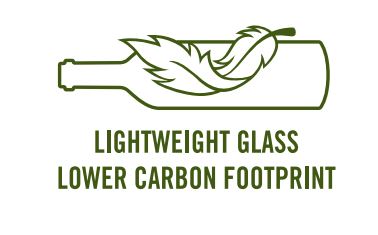
Crimson has made significant strides in sustainability by reducing their bottle weights since 2018, achieving a remarkable 17% reduction between 2018 and 2023, equivalent to removing 633,000 miles driven by gasoline powered cars every year. By reducing the weight of its bottles, Crimson aims to lower its environmental impact and contribute towards a more sustainable future. In addition, the company remains dedicated to sourcing a majority of its glass, including a high percentage of recycled cullets or glass fragments, from California as it works to further reduce its environmental impact.
Crimson recognizes that reducing bottle weight is critically important in the effort to lower Greenhouse Gases. It not only diminishes the carbon emissions from glass production, but also reduces the transportation footprint. Lighter bottles require less raw materials, thus reducing the use of resources and energy in production. Moreover, lighter bottles also contribute to a lower transportation weight, resulting in reduced emissions from the bottling line all the way to the end consumer. With this commitment towards lowering their carbon footprint, Crimson aims to reach an average bottle weight of 400 grams by 2028, which is 27% below the current industry average of 550 grams. This underscores their dedication to sustainability and sets a compelling example for other companies in the industry to follow.
With this significant decrease, Crimson has introduced a distinctive new light-weight glass logo to be included on labels of wine bottles that meet the benchmark weight of 420 grams and below. With the collaboration of industry partners, retailers, and restaurants, Crimson Wine Group is offering free use of their logo for promotions that include wine bottles weighing 420 grams or less. This initiative aims to educate consumers about the significance of their glass choice in wine bottles, encouraging them to prioritize lighter weight options.
Jennifer Locke, CEO of Crimson Wine Group, emphasizes their commitment, saying, “As consumers become more aware of the impact their purchases have, it is important for businesses to take responsibility and make environmentally conscious choices. We recognize the inherent connection between climate change and the wine industry and we are steadfast in our pursuit to reduce our company’s carbon footprint while also working alongside our industry partners to promote lower emissions. For too long, ultra-heavy bottles have been associated with luxury wines, creating a false perception that they are of higher quality. However, the truth is that the weight of a bottle has no bearing on the quality of wine. By prioritizing sustainability and actively seeking to reduce our carbon footprint, we hope to set an example for others in the industry to follow.”
Crimson’s most significant glass reduction will be achieved at their Pine Ridge Vineyards estate, based in Napa, CA. The estate has been actively reducing the glass weight for its highest production Chenin Blanc + Viognier White Blend by 24% since 2018. The latest bottle change for the 2023 vintage will significantly decrease the weight of the bottle, from 469 grams to a mere 404 grams. This ultra-lightweight bottle will be used for the largest wine produced within their portfolio and is expected to remove approximately 100 metric tons of carbon dioxide equivalent annually.
Pine Ridge Vineyards also recently launched its new Traveler’s Series Cabernet Sauvignon that features a light bottle weight of 396 grams for its inaugural vintage. This makes it the lightest glass available domestically on the market, and certainly the lightest weight luxury priced wine at $40+, further solidifying Crimson Wine Group’s commitment to lighter weight bottles.
Additionally, Crimson Wine Group has made significant progress lowering the glass weight for their second largest brand by volume, Seghesio Family Vineyards, based in Healdsburg, CA. The winery’s Sonoma Zinfandel, the #1 Zinfandel sold in the U.S. above $20, has reduced its weight by 17% since the 2018 vintage, the equivalent of removing 90 metric tons of carbon dioxide.
“The progress that we’ve made to-date with the glass weight reduction is an extraordinary feat,” says Nicolas Quillé, Master of Wine, Chief Winegrowing and Operations Officer. “Our goal is to push the boundaries further and reduce our footprint to 557 metric tons of carbon dioxide equivalent from 950 tons currently in just five years. To reach this figure, we will undoubtedly continue to look at innovation to get us there. By taking this proactive stance, we hope to inspire other companies in the wine industry to follow suit and prioritize sustainability.”